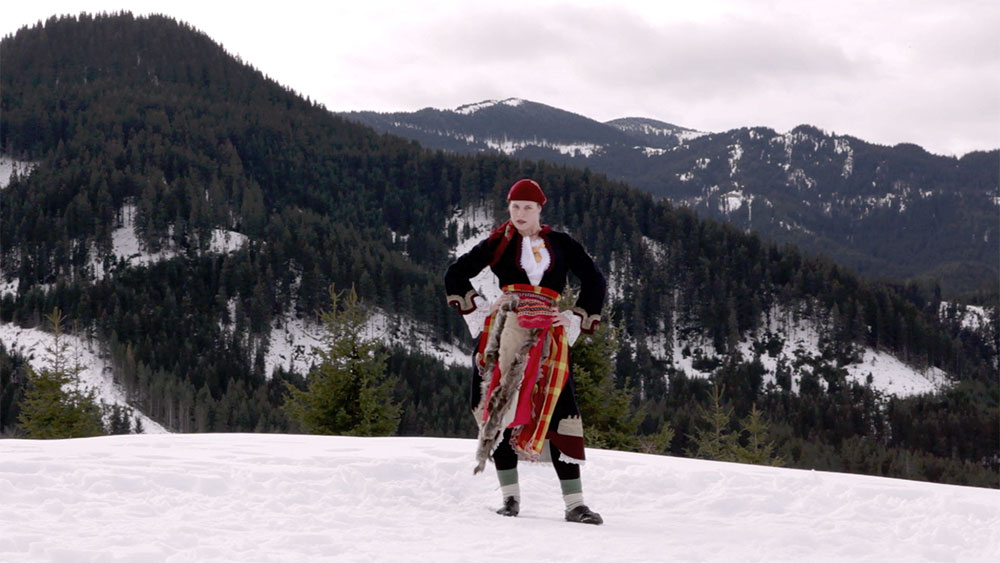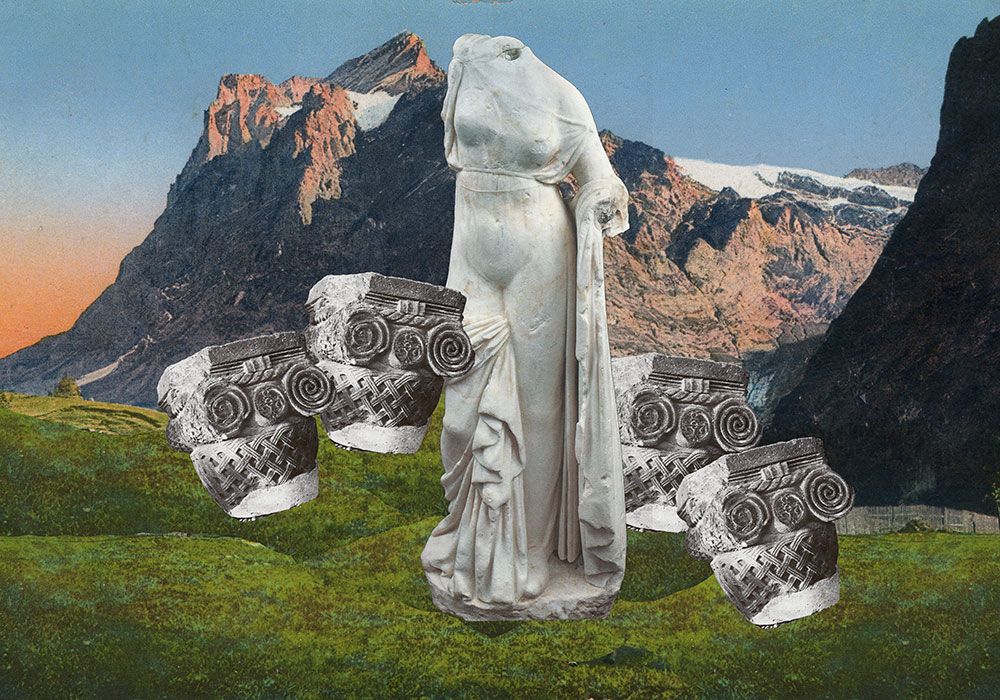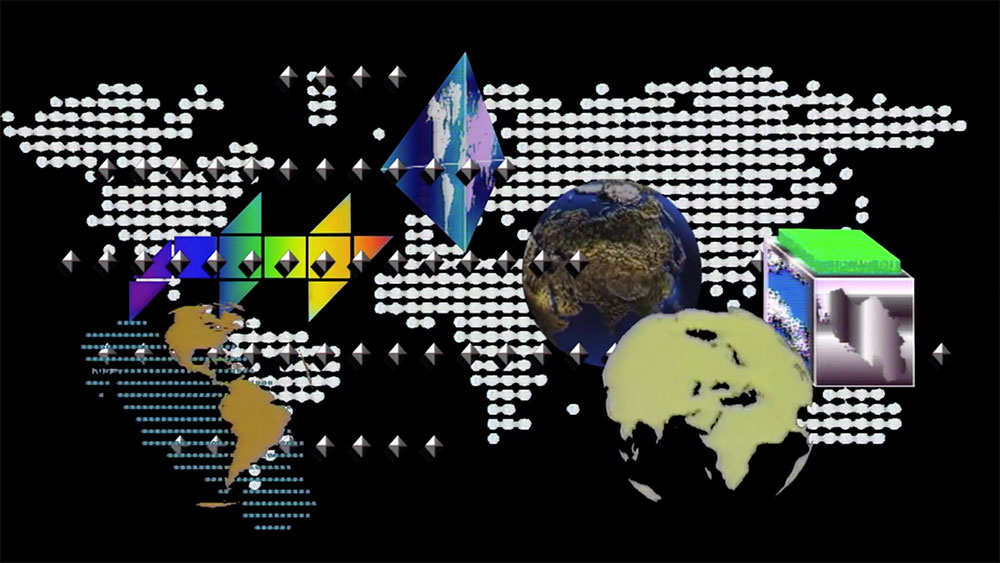Post-internet art
Balkan idol
Meet the artist who lit up the internet in Bulgaria, with a bit of help from Beyoncé
If the last couple of months are anything to go by, there’s no better pop star than Beyoncé when it comes to giving voice to stifled cultural narratives. Her latest visual album, Lemonade, has amassed millions of views, many of which laud Bey — who dons tribal paint and braided crown — for connecting with African-American history, African tribalism and ancient religions. Some have even gone as far as drawing comparisons between the star and Oshun, the Yoruba deity of love, for her choice of outfit in Hold Up. This intersection between pop and folk, as well as the figure of the diva, is at the centre of Gery Georgieva’s work.
“There’s something divine about the way the diva can channel her struggle and emotion to a whole group of people,” the British-Bulgarian artist tells me when I meet her at her London studio. Georgieva makes video and installations but is first and foremost a performer. Last year she experienced her own stint of viral fame, when a video of Georgieva dressed in Bulgarian national costume dancing in the mountains of the Balkan country began to circulate online, gaining a mixed response from Bulgarians. The video, Rodopska Beyoncé (Autoethnography II), is missing the backing track but it’s easy to spot the moves from Beyonce’s singledom anthem Single Ladies — sassy head jerk and imaginary ring flashing included.
“Beyoncé has this phenomenon around her which I found particularly interesting because it’s so widespread, so global, and folk culture is about being local. I quite liked looking at the two together. But mainly I picked it because it had a real effect on me. I wanted to learn the dance as much as all the other people on the internet. What’s funny is that one of the news channels in Bulgaria showed my video and put the original song back over the top. The responses were even more vitriolic, as it became more vulgarised in a way — to do a full on sexy pop dance with music whilst wearing the local national dress, people found it more offensive. Removing the music makes the work speak on so many levels — it opens it up.”
Georgieva’s interest in the diva figure has less to do with celebrity misdemeanour and more to do with a singer’s role as an orator. Yet, a major factor in Beyonce’s influence is that she transcends language: you don’t necessarily need to know English to connect with her. Georgieva also sings in her works. In Solo Romantika and Balkan Idol she sings in Bulgarian, and even went to her native country to take a masterclass under Maria Leshkova, one of the soloists from the world famous choir The Mystery of the Bulgarian Voices. Three years ago she started collaborating with Canadian-Bulgarian producer Patchfinder on a musical project by the name of Vera Modena, which gives her space to experiment with the folk songs she learned during her time at the workshop. “It’s not about taking a folk song and trying to modernise it but trying to unlock and play with all these different messages in folk culture, which in many ways is still in a lot of hip-hop culture: songs about having money and finding a good man or woman. I find there’s relatability between current music and the stuff that we found.”
Collaboration between Gery Georgieva’s music alter-ego Vera Modena and Patchfinder
Alicia Keys songs feature alongside Beyonce’s in Georgieva’s videos. Georgieva is interested in how a these women serve as role models, showing girls they can also be like that. “Mimicry is a very important part of learning in general but also passing on culture and inhabiting performance.” But there’s a fine line between speaking for someone and speaking over them, particularly when a whole cultural history is at stake.
“I was interested in the possibility of making up your own DIY folkiness based on what you imagine an exotic place to be like”
Georgieva shows how lip-syncing Alicia Keys or dancing to Beyoncé can be empowering. The artist is equally concerned with the way in which local culture is muted or manipulated. In Getaway, a video created largely during a during a two week residency at ICA Singapore in 2015, Georgieva records herself dancing and lipsyncing a Lykke Li song. She tries to seduce the viewer. The flow is interrupted with flashes of diaristic footage of everyday life recorded on her phone. These interjections of reality are a clue to what else is happening in the work. Borrowing the tropes of holiday ads, the artist experiments with what it means to take objects out of daily life and package them as symbols of authenticity.
“The costume in that video is made up of a beaded car seat covering. I was thinking of ideas of things that only exist in certain places and domestic folk cultures. Those car seat covers, we don’t really see them in the west just because they belong to a certain climate, and there is a different attitude and culture to personalising the interior of vehicles in the UK. So I was interested in the possibility of making up your own DIY folkiness based on what you imagine an exotic place to be like.” Interested in the way culture is performed and preserved, for her second year degree show at Goldsmiths she featured two actors wearing kukeri-style Bulgarian masks made to look entirely like waxworks, displayed in an ethnographic cabinet.
For Balkan Idol, last year’s Frieze Film commission, Georgieva returned to Bulgaria to look for alternative places that embody culture. She travelled to the derelict Buzludzha monument, where Georgieva is seen singing a native folk song. The second part of the video was filmed in one of the nighclubs on Bulgaria’s chalga scene, where the artist again takes to the dancefloor. Both spaces have a contested relationship with national identity. The Buzludzha monument was built in 1981 as both a tribute to the country’s liberation from Ottoman rule and the socialists who gathered on the mountain peak who went to define Bulgarian socialism thereafter. As a reminder of communism and its oppressive past, it was abandoned after 1990. Chalga nightclubs and chalga music — a style that developed after 1989, fusing pop, folk and eastern elements — is considered trashy by some Bulgarians who deride its ties to the mafia lifestye, corruption and influence of oriental style. However, the artist is fascinated by trash for the same reason she’s fascinated by pop: it goes beyond language and “is powerful because, often, it can grab a huge number of people.”
Juxtaposed in this way, the effect in Balkan Idol is not dissimilar to that of Getaway. Georgieva’s performance in the ruin is reserved, her movements are contained, while the club choreography is sensual and self aware. “I found so many people would go around filming the monument and soaking in the ruins and the nostalgia. The idea of looking at the monument is not enough. How do you actually respond to it? The thing I found about the two spaces is that they both have a sense of occasion. The monument was created for communal meetings, so there is a prescribed social etiquette to their unity. At nightclubs, especially these chalga nightclubs, their surroundings invite you to behave in an excessive way. I love how they are entirely constructed out of ornaments. Everything is made rich and dripping. It’s a dream of excess — and that’s where you let go.”
Balkan Idol (2015)
“There’s this idea that the internet is a way of accessing faraway cultures, but plenty of places put up their own music and don’t need to be discovered”
Though Georgieva doesn’t consider herself an internet artist, her videos, and particularly her earlier works, are undeniably influenced the DIY nature of Youtube. Getaway, for example, was originally based on an ASMR video that centres around an anthropology book, while Rodopska Beyoncé recalls the phenomenon of amateur dance videos. On the place of culture on the internet, she says: “There’s this idea that the internet is a way of accessing faraway cultures, but plenty of places put up their own music and don’t need to be discovered — auto-ethnography, which is also the title of the Beyoncé video, relates to this. We don’t need to send an anthropologist out to certain places to translate what they say to us. We have direct access via these people uploading things, which makes things feel closer. This makes local cultures feel like they must be defensive of their boundaries, which also gives folk culture more of a salient position in a lot of countries that are trying to market tourism industries.”
Text: Liza Premiyak
Image: Gery Georgieva


